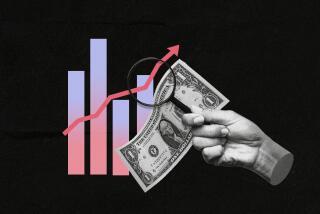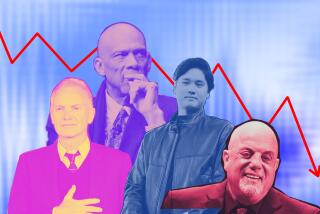Few Feel Market’s ‘Wealth Effect’
- Share via
With the stock market having a spectacular 1987 so far, the “wealth effect” theory has surfaced anew. Some analysts hope that the great personal wealth created by the financial market’s mega-rally in the past few years, along with the sense of well-being that it has generated, will encourage financial asset holders to go on a shopping spree.
No one argues that a boost in consumption is sorely needed: The consumer, who in recent quarters has been carrying the economy, is deeply in debt and seems near exhaustion. But whether this new wealth will be spent is another question.
Institutions such as pension funds hold the bulk of financial assets, and of the assets owned by individuals, stocks and bonds are among the most narrowly held. Only one in five households directly owns any stocks or mutual fund shares, and only one in 12 has any bonds or other credit market instruments. Lately, with the markets booming, many small investors have been drawn to stocks and bonds, especially through mutual funds, but those who have meaningful sums invested in such assets still are few. More important, they tend to already be wealthy: Among stock owners, those in the over-$48,000 income bracket held, on average, about $56,000 in stock and mutual funds in 1984, compared to $16,000 for stock investors in the $24,000-$48,000 bracket.
Thus, as financial assets appreciate, the gains accrue mostly to high-income families, who are the least likely to spend them. The roughly 10% of U.S. families in the $48,000-plus group aren’t big spenders: They save about 28% of their incomes. And marginal savings rates--the portion of each additional dollar of income that is saved--are probably approaching 100% for the wealthier households.
Moreover, recent surveys indicate that heavy spending from capital gains by these high-income households is even less likely now. Among stockholders over 45--those old enough to remember severe bear markets of the past--confidence in the health of the economy has been on the wane for several months. True, young investors are still optimistic, and their enthusiasm has contributed to consumption growth in recent quarters. But older investors tend to be richer, and their bearishness will probably outweigh the optimism of the younger set.
Optimism Could Fade
Plus, what optimism there is may be reversed quickly if a stock market correction occurs, or even if the recent volatility persists. During their ongoing consumption binge, many investors in the under-45 age group have been piling up debt, confident that appreciation of their financial assets will outpace growth of their liabilities. Now, they may see their paper gains evaporate overnight or experience wide swings, while debts remain unchanged.
Many among the shrewder investors also worry about the underlying value of their assets--and with good cause. Stock prices have risen largely as a result of higher price-to-earnings ratios, which increase as interest rates fall and a lower discounting rate is applied to the stream of future earnings. Earnings themselves, however, have been disappointing. In addition, with the end of inflation and the collapse in tangible asset prices, the value of the assets that produce those earnings has been flat or declining every year since 1980.
More important from the consumer standpoint is that while financial assets are gaining, the value of more commonly held assets is dwindling. Private homes, for instance, are the cornerstone of most Americans’ net worth, with more than 64% of consumers holding equity in their homes. However, the inflation-adjusted value of housing nationally has barely risen since 1978, while mortgage debt has continued to soar, resulting in a 13% decline in home equity between its 1981 peak and 1985. My firm estimates that the double-digit rise in mortgage debt in 1986 further reduced home equity, probably to around 54% of home value. This is sharply lower than the 64% level of just five years ago, and only a notch above the all-time low of 53% reached in 1966. Since the new tax law makes borrowing against the home the preferred form of raising funds, this record is certain to be broken this year, and sometime soon we will enter uncharted territory.
Drop in Equity Holdings
The same is happening with consumers’ other assets. Even though the prices of such items as cars, furniture and jewelry have continued to rise, the rapidly rising non-mortgage debt has sapped their net value, and such actual equity holdings have dropped by almost 15% since the 1980 peak.
The dramatic erosion of these very broadly held forms of wealth is indicative of the declining net worth of low- and moderate-income households. Excluding the increase in the value of stocks, bonds and pension funds, consumers’ net worth fell 2.5% in 1985, the latest year for which data are available, and likely declined further in 1986, despite the expanding economy.
Even as the stock market booms, implying a rise in the value of American companies, the value of non-corporate equity--proprietorships and partnerships--is slipping badly. Interestingly, the steepest decline occurred not in the recessionary 1982, as would be expected, but in 1985.
In part, this reflects the crisis in U.S. agriculture--farmers lost nearly half the value of their businesses between 1979 and 1985--but non-farm partnerships and proprietary businesses also fared badly. And the situation almost certainly worsened in 1986, when the farm crisis deepened and collapsing oil, office space and other real estate prices lowered the value of many limited partnerships. The fact that many older, wealthier investors are also participants in real estate- and oil-based tax shelters may account for their pessimism. They see profits come into one hand and out the other.
In all, real private tangible net worth in the United States fell 0.8% in 1985, a decline exceeded but once in the post-World War II period, in 1982, amid a severe recession. Since financial assets ultimately represent claims on tangible assets, this measure, in effect, gauges the basic buying power of Americans. And last year’s lackluster performance of real GNP and the decline in net savings as a percent of GNP make it likely that in 1986 physical wealth posted a second consecutive annual decline.
The effect of the financial market boom mirrors developments on the personal income side: The lucky few, concentrated in the upper-income brackets, are pulling away, while the average wage earner is being squeezed by cost control. The decline in total private net worth is probably a sign that consumers are trying to hold onto life styles they can no longer afford by borrowing and drawing down their assets.
However, once they realize that the shortfall in incomes is permanent and not a temporary aberration, many consumers will curb their expenditures. Since those whose net worth is increasing--the affluent households--are unlikely to make up for this shortfall, the consequences for the consumer-driven U.S. economy may be very serious.
More to Read
Inside the business of entertainment
The Wide Shot brings you news, analysis and insights on everything from streaming wars to production — and what it all means for the future.
You may occasionally receive promotional content from the Los Angeles Times.










